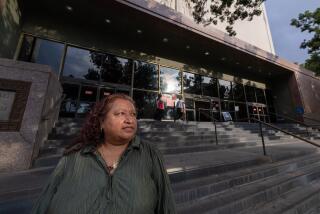Women Lawyers See Roles Beyond the Courtroom and Their Homes: Law as a ‘Change Vehicle’ of Society
A busy Encino environment and land-use lawyer, Janice Kamenir-Reznik, takes half an hour from her practice each day to drive her 5-year-old daughter and a car full of classmates home from the kindergarten across the street from her office.
Kamenir-Reznik, 36, can take time for car pools without checking with her firm’s senior partner because she is the senior partner.
She and her husband, Benjamin Reznik, balance a Sherman Oaks law practice, a nearby Encino home and three children.
Just added to the demands of her 18-hour day is the presidency of California Women Lawyers, an organization created nearly 15 years ago when few women achieved such well-blended family and career success.
19,000 Women Lawyers Belong
About 19,000 women lawyers pay up to $60 a year to support the organization. Its purposes, as stated by its founders: “To advance women in the profession of law; to improve the administration of justice; to better the position of women in society, and to eliminate all inequities based upon sex.”
The group has written friend-of-the-court briefs advocating affirmative action, abortion rights, parental leave and comparable worth, and criticizing discriminatory clubs. It has also drafted and lobbied for legislation relating to reproductive rights, equal education, spousal support, sexual assault and child care.
Women are rapidly moving into the mainstream of California’s legal community: 50% of law school graduates, 25% of the state’s 114,200 lawyers and 15% of the state’s 1,330 judges are women.
Although neither the women lawyers’ Sacramento headquarters nor the State Bar of California could determine how many women lawyers the state had in 1974, two of the group’s early members recalled that there were never lines to the ladies’ rooms at bar conventions then, as there are now.
When Justice Joan Dempsey Klein of the state’s 2nd District Court of Appeal served as founding president of California Women Lawyers, she was a Los Angeles Municipal judge, then one of a mere handful of women on the bench. When she completed law school in 1955, just two of the 90 in her class were women.
‘A Lot More Comfortable’
And when Margaret M. Morrow joined the firm of Kadison Pfaelzer Woodward Quinn & Rossi in 1974, two of its then-26 lawyers were women. By comparison, her new firm of Quinn, Kelly & Morrow, which she and other departing Kadison lawyers recently formed, has nine women among its 21 lawyers.
“It is a lot more comfortable feeling today than it was back then,” Morrow said. “The numbers of women being graduated out of law school, being hired and being promoted to partner is increasing dramatically, and with that has come the security and the network of colleagues we lacked 10 to 15 years ago.”
Despite the significant movement of women into the mainstream of the legal profession, women bar leaders agreed at a recent meeting that the California Women Lawyers organization is still needed to promote women’s issues.
Morrow is the second woman president of the nation’s largest voluntary bar organization, the 25,000-member Los Angeles County Bar Assn. But acceptance of women by the larger all-purpose bar groups, she said, does not negate the need for California Women Lawyers.
“There is a pattern of successful integration into the general-purpose bar association,” she said. “But the general association must take positions that satisfy most of the members some of the time. It is hard for a bar association like that to take a strong active voice on women’s issues.”
Marjorie L. Carter, a Newport Beach lawyer who is on the California Women Lawyers board of directors, said a separate group is needed to focus on women’s issues. “We are definitely oriented toward the family, toward women’s problems.”
Kamenir-Reznik brings to her new job as chief advocate for the women’s group a lifelong interest in social and public interest issues. Brought up in West Los Angeles and the Pacific Palisades, she earned a bachelor’s degree in psychology at UCLA in 1973 and a joint master’s degree in social work from USC and in Jewish communal studies from Hebrew Union College in 1975.
More interested in lobbying and working for civil rights than in one-on-one counseling, she became director of the Commission on Soviet Jewry for the Jewish Federation Council of Greater Los Angeles.
She married just after their college graduation, then watched with interest as her husband completed law school and set up a solo practice in zoning and land-use law, with emphasis on pro bono cases--representing litigants without fee.
“I had never thought of law as being the change vehicle in the way I thought of social work,” she said. “But watching Ben alerted me that we were doing the same things.”
So she enrolled in UCLA Law School and graduated in 1982, just before giving birth to their oldest son, Yoni, 6.
Together, she and her husband expanded their new firm, Reznik & Reznik, employing four additional lawyers. They also expanded their family, adding daughter, Devorah, 5, and son, Sampson, 18 months.
Kamenir-Reznik’s agenda as president of California Women Lawyers adheres to the organization’s purposes:
- To advance women in the profession of law and improve the administration of justice, she intends to continue the group’s effort to get more women appointed to the bench.
- To better women’s position in society, she will work to expand child care facilities throughout the state.
- To eliminate inequities based on sex, she hopes to survey any discrimination problems that may remain for women pursuing legal careers.
Reviewing judicial appointments, the new president gave Gov. George Deukmejian high marks for his appointment of about 100 women judges in the last 6 years.
In that time, she said, 25% of the 398 women who applied for judgeships got them; of the 2,333 men who applied, 23% got judgeships.
As more women lawyers earn the experience required for the bench--5 years of law practice for Municipal Court and 10 for Superior--it appears likely that the percentage of women judges will increase. But the women lawyers do not intend to leave that to chance.
“The (Deukmejian) Administration sends us the message get more women to apply ,” Kamenir-Reznik said. “And that is one thing for us to work on . . . particularly in rural communities.”
While women lawyers can afford $150 to $200 a week to hire child care in their own homes, they know many working women cannot.
Child Care for Poor Families
So another major goal for Kamenir-Reznik and California Women Lawyers this year is to develop more child-care facilities for low- or middle-income parents.
Kamenir-Reznik’s goal is to train lawyers of both sexes to work pro bono to obtain permits for child- care facilities in residential areas.
She wins strong support from Morrow, who personally urges all lawyers to take pro bono cases and who sees child care as a primary issue for all working women.
“There are only 20 to 25 spaces for every 100 children who need child care, and in Los Angeles it’s only about 15 for every 100,” Kamenir-Reznik said.
“As lawyers, we have the skills to improve society. It would be sad if our only agenda was to better the position of women lawyers. And child care is right up there on the global priority list. It is the No. 1 issue for women.”
Despite women’s gains in the legal profession, the group’s leaders still believe that women’s climb toward the highest-paying partner positions may be harder than men’s in some law offices and that women who take time off to have babies or care for children get derailed onto a lower-paying “mommy track.”
But they concede that they have no facts or details to substantiate their suspicion.
“In general I think we’re sort of entering a second stage,” said Grace E. Emery, president of Orange County Women Lawyers, a local affiliate of the statewide group. “We have gained access to courtrooms.”
Double Bind of Home Care
But women lawyers are now encountering “new, subtler forms of discrimination,” she said, with much of the problem having to do with women in corporate law firms being expected to spend as much time at work as their male peers, even though many of the women must also care for children at home. Rather than neglect their families, Emery said, a lot of women simply drop out of the corporate world.
To determine what problems may still exist, Kamenir-Reznik has set another priority: funding a survey of all women lawyers in the state.
Developed by the State Bar’s Committee on the Status of Women in Law, with the help of California Women Lawyers, the survey will seek information about women lawyers and their employers.
Times staff writer Laura Kurtzman contributed to this story from Orange County.
More to Read
Get the L.A. Times Politics newsletter
Deeply reported insights into legislation, politics and policy from Sacramento, Washington and beyond. In your inbox three times per week.
You may occasionally receive promotional content from the Los Angeles Times.










